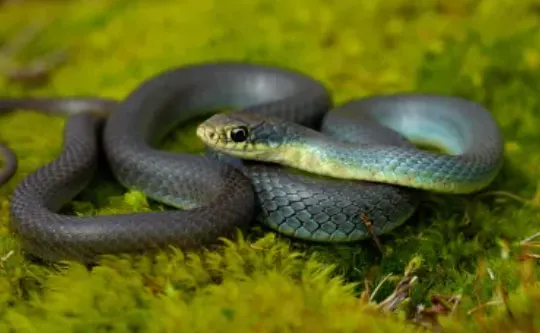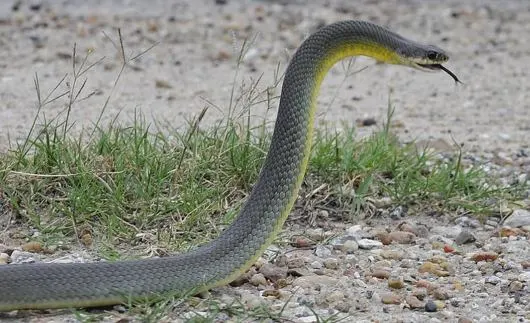The Eastern Racer (Coluber constrictor), known for its speed and agility, is one of North America’s most common snakes. Found mainly in the U.S. east of the Rocky Mountains, this non-venomous snake is often seen in habitats ranging from dry fields to forest edges. With its sleek, slender body and keen eyesight, the Eastern Racer is a master at evading predators and catching prey.

Table of Contents
Quick Facts About the Eastern Racer
- Scientific Name: Coluber constrictor
- Common Name: Eastern Racer
- Lifespan: Up to 10 years
- Length: 35 to 75 inches
- Venomous: No
- Conservation Status: Least Concern
Speed and Agility: A Fast Hunter
One of the defining features of the Eastern Racer is its speed. Often clocking at up to 4 miles per hour, it’s one of the fastest snakes in the world. This speed, combined with its excellent vision, makes it a swift and efficient hunter. Eastern Racers raise their heads above the grass to scout for movement, then dash toward their prey, often small mammals, birds, or even other reptiles.
Despite its name, the Eastern Racer doesn’t “constrict” its prey like other snakes. Instead, it subdues its prey with sheer strength, sometimes even swallowing smaller animals alive.
Different Subspecies of Eastern Racers
The Eastern Racer has several subspecies, each with slight differences in color and habitat preferences. Some of the notable subspecies include:
- Northern Black Racer (C. constrictor constrictor): Found in the southern United States, this racer is known for its sleek black appearance.
- Blue Racer (C. constrictor foxii): Common in the Great Lakes region, this subspecies features a striking blue coloration.
- Yellowbelly Racer (C. constrictor flaviventris): With a pale yellow belly, this racer is often found in central U.S. regions.
Each of these racers is well-adapted to its environment, making the most of available cover and
Behavior and Habitat
Eastern Racers are diurnal, meaning they are active during the day. Their preferred habitats are dry and open areas like fields, meadows, and grasslands, but they’re also found in forests and along edges of human habitats. They’re not shy and can often be spotted hunting or basking in the sun.
Though solitary by nature, they are occasionally seen in groups during mating season. Males and females look quite similar, but males have longer tails, sometimes with a noticeable bulge.
Reproduction and Life Cycle
Mating occurs in spring, from April to early June. After mating, females lay between 3 to 32 eggs in protected areas like abandoned burrows or under rotting stumps. Interestingly, Eastern Racers may sometimes share communal nesting sites with other snake species.
Eggs hatch in late summer, with the young snakes—about 14 inches long at birth—ready to fend for themselves. Males mature at around one year, while females take two to three years to reach sexual maturity.
Importance in the Ecosystem
Eastern Racers play a significant role in their ecosystems as both predators and prey. As mid-level predators, they help control populations of small mammals, birds, and insects. They are also preyed upon by larger animals such as birds of prey, coyotes, and even domestic cats and dogs.
Their presence is beneficial to humans, as they help keep vermin populations in check. Unfortunately, they’re often mistaken for venomous snakes like cottonmouths and are sometimes killed out of fear.
Interaction With Humans
Despite their sometimes “mean” reputation, Eastern Racers are not aggressive unless provoked. If handled or cornered, they may bite repeatedly and release foul-smelling substances from their cloaca, a defensive tactic. While their bite isn’t venomous, it can be painful and may break the skin, so it’s essential to clean any bite wounds thoroughly.
Conservation Status: Least Concern
Thankfully, Eastern Racers are abundant across their range, and their conservation status is listed as “Least Concern.” However, some subspecies are protected in specific areas like Ontario, Louisiana, and Maine due to declining populations. Human activities, including habitat destruction and direct killing, pose risks to certain populations, but overall, the species is thriving.
How to Identify an Eastern Racer
Eastern Racers are long and slender, ranging from 35 to 75 inches in length. They usually weigh a little over a pound, with smooth, solid-colored scales on their back and lighter-colored bellies (typically white, cream, or yellow). Juveniles often have a distinct, patchy pattern that fades as they mature.
The snake’s large eyes and excellent vision make it easy to identify, especially when it raises its head above the grass to look around. While not overly aggressive, they dislike being handled and may struggle violently if restrained.

Fun Facts About Eastern Racers
- Top Speed: Eastern Racers can slither at speeds of up to 4 miles per hour.
- State Reptile: The Northern Black Racer is the state reptile of Ohio.
- Great Climbers: Eastern Racers are skilled climbers, often hunting birds and their eggs in trees.
- Tail Tactics: When cornered, an Eastern Racer may rapidly shake its tail in leaves or debris, mimicking the sound of a rattlesnake.
A Vital Part of the Ecosystem
The Eastern Racer, though often misunderstood, is a fascinating and vital part of the ecosystem. Its speed and agility make it one of the most effective hunters among snakes, and its presence helps balance populations of small animals. Though it may not be the most sociable creature, it plays a critical role in maintaining healthy ecosystems and reducing pests that can affect human habitats. Whether you spot one darting across a field or slithering up a tree, this snake is a true marvel of nature.
- Enchi Ball Python: A Unique and Stunning Morph of Python regius - March 27, 2025
- Emerald Tree Monitor: The Enigmatic Green Guardian of the Rainforest - March 26, 2025
- The Egyptian Cobra (Naja haje): A Fascinating Serpent - March 25, 2025
